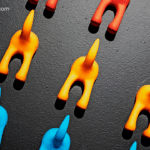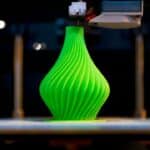
In 2025, the fusion of artificial intelligence (AI) and 3D printing is transforming how we design and create home decor. From intricate lattice lampshades to personalized parametric wall panels, AI is empowering both hobbyists and professionals to craft stunning, bespoke decor pieces with unprecedented ease and precision. This article explores how AI tools are revolutionizing 3D printed home decor, offering a deep dive into AI-driven design software, generative design techniques, in-print monitoring, and real-world examples. Whether you’re a DIY enthusiast or a seasoned designer, discover how AI can elevate your 3D printing projects to create decor that’s as unique as your home.
Affiliate Disclosure
We participate in Amazon affiliate programs, earning fees from qualifying purchases via links at no extra cost to you. It’s how we keep this blog rolling and my 3D printers buzzing with fresh filament for reviews like this one!
For more on this trend, read A Detailed Look Into the Rise of 3D-Printed Home Decor in 2025.
Why AI and 3D Printing Are a Perfect Match for Home Decor
AI is reshaping industries, and 3D printing for home decor is no exception. Unlike traditional manufacturing, 3D printing allows for limitless customization, and AI enhances this by automating complex design processes, optimizing print workflows, and ensuring flawless results. In 2025, AI’s role in consumer 3D printing is an emerging trend, particularly for home decor, where personalization and aesthetics are paramount.
For inspiration on what to create, see Cool Things to 3D Print.
Key Benefits of AI in 3D Printed Home Decor
- Simplified Design: AI tools enable non-experts to create intricate designs without advanced CAD skills.
- Personalization: Generative design algorithms produce unique patterns tailored to user preferences.
- Print Optimization: AI-driven monitoring reduces print failures, saving time and materials.
- Innovation: AI unlocks complex geometries (e.g., organic shapes, lattices) that elevate decor aesthetics.
AI Tools Transforming 3D Printed Home Decor
AI is integrated into 3D printing workflows at multiple stages, from design to printing. Below, we explore the key tools driving this revolution and how they’re applied to home decor.
For a deeper look at AI in 3D printing, check out How to Use Grok 3 for 3D Printing.
1. AI-Driven Design Software
AI-powered design platforms make it easier to create decor pieces that are both functional and visually striking. These tools analyze user inputs (e.g., style preferences, dimensions) to generate designs that would be time-consuming or impossible to create manually.
- Autodesk Generative Design: Part of Autodesk Fusion 360, this tool uses AI to generate multiple design options based on parameters like size, material, and aesthetic goals. For example, a user designing a 3D printed vase can input “minimalist, lightweight, floral-inspired” and receive dozens of unique designs, such as vases with organic, lattice-like structures. Learn more at Autodesk Generative Design.
- nTopology: This advanced software uses AI to create complex geometries for decor, like parametric wall panels with intricate patterns. It’s ideal for professionals looking to push the boundaries of decor design.
- Free Tools for Beginners: Platforms like Tinkercad now integrate basic AI features, such as auto-suggestion for shapes or patterns, allowing beginners to design custom coasters or picture frames with minimal effort. For more design tips, see Designing Your Own 3D Printed Decor.
2. Generative Design for Unique Decor Patterns
Generative design, an AI-driven process, creates organic, complex patterns that are perfect for home decor. Unlike traditional design, which relies on human creativity alone, generative design explores thousands of iterations to find the optimal solution.
- Applications in Decor: Generative design is ideal for creating decor with organic or parametric patterns, such as:
- Lattice Lampshades: AI generates lightweight, intricate lattices that diffuse light beautifully.
- Parametric Wall Panels: Custom wall art with flowing, wave-like patterns that add texture to a room.
- Sculptural Centerpieces: Unique table decor with biomorphic shapes that mimic natural forms.
- How It Works: Users input constraints (e.g., size, material strength, aesthetic style), and the AI generates designs optimized for 3D printing, reducing material waste and print time.
3. In-Print Monitoring with AI
AI isn’t just for design—it also ensures flawless 3D prints. In 2025, advanced 3D printers integrate AI-driven monitoring systems to detect and correct issues during printing, which is critical for intricate decor pieces. To choose the right printer for these tasks, check out Best 3D Printers for Home Use.
- Spaghetti Detection: Tools like Obico use AI to monitor prints via webcam, detecting failures like “spaghetti” (tangled filament) and pausing the print to save materials. Learn more at Obico.
- Print Optimization: AI algorithms adjust print settings in real-time (e.g., layer height, speed) to prevent warping or stringing, ensuring high-quality decor items like vases or sculptures.
- Consumer Printers: Brands like Bambu Lab have introduced AI-assisted printers (e.g., Bambu Lab H2D with built-in cameras) that alert users to issues via apps, making it easier to print decor at home. Visit Bambu Lab.
Real-World Examples: AI-Generated 3D Printed Decor
To illustrate AI’s impact, here are real-world examples of how designers and hobbyists are using AI to create stunning 3D printed home decor in 2025. For more inspiration, see Cool Things to 3D Print.
- Lattice Lampshades by Studio X: A small design studio uses Autodesk Generative Design to create lightweight, lattice-patterned lampshades printed in transparent resin. The AI-generated patterns maximize light diffusion while minimizing material use, creating a sustainable yet luxurious decor piece.
- Parametric Wall Art by DIY Creators: A popular YouTube channel showcases a DIY project where a hobbyist uses nTopology to design a 3D printed wall panel with a flowing, organic pattern. The panel, printed in PETG, adds a modern focal point to a minimalist bedroom.
- Personalized Planters by Local Makers: A community maker space uses Tinkercad’s AI features to help beginners design custom planters with engraved patterns, such as names or geometric shapes, printed in biodegradable PLA for eco-conscious decor.
Tutorial: Designing a 3D Printed Decor Piece with Free AI Tools
Want to create your own AI-designed 3D printed decor? Follow this step-by-step guide using free tools accessible to beginners. For more design guidance, visit Designing Your Own 3D Printed Decor.
- Choose a Design Platform
- Use Tinkercad for its AI-assisted features like shape suggestions and pattern generators.
- Define Your Decor Project
- Example: Design a 3D printed coaster with a geometric pattern.
- Input parameters: Size (10 cm diameter), material (PLA), style (modern, hexagonal pattern).
- Use AI to Generate the Design
- In Tinkercad, select a base shape (e.g., a flat circle) and use the “Pattern Generator” to apply an AI-suggested hexagonal lattice.
- Adjust parameters like thickness (2 mm) and pattern density to suit your printer.
- Export and Slice
- Export the design as an STL file.
- Use a slicer like Cura with AI plugins to optimize print settings for your 3D printer.
- Print and Post-Process
- Print the coaster on a consumer 3D printer (e.g., Creality Ender-3 V3).
- Post-process by sanding lightly and painting with acrylic for a polished look.
Pro Tip: Use Obico’s free tier to monitor your print remotely and avoid failures.
Interviews with Designers: AI in Action
To gain insight into AI’s role in 3D printed decor, we spoke with two designers pushing the boundaries of this technology.
- Emma Chen, Independent Designer: “I use Autodesk Generative Design to create 3D printed vases with organic shapes that would take weeks to model manually. AI lets me experiment with forms that feel alive, like coral or vines, which clients love for their homes.”
- Liam Patel, Maker Community Leader: “At our local maker space, we’re using free AI tools like Tinkercad to teach beginners how to design decor. The AI suggestions make it accessible, and people are amazed when they print their first custom lamp base.”
Emerging Trends in AI for 3D Printed Home Decor
AI is not only transforming how we create decor but also shaping its future. Here are key trends driving this revolution in 2025, supported by insights from The Top 3D Printing Trends to Watch in 2025.
- AI-Enabled Design Customization: AI tools like Bambu Lab’s PrintMon Maker allow users to create bespoke decor by inputting simple prompts, democratizing design for beginners and small businesses. This trend is boosting sales for Etsy sellers offering unique 3D printed decor.
- Sustainable Practices: AI optimizes designs for minimal material use and eco-friendly filaments like biodegradable PLA, aligning with the demand for sustainable home products. Learn more about eco-friendly printing at Sustainable Decor.
- Smart Home Integration: AI-designed decor is incorporating smart features, such as lamps with sensors that adjust light based on occupancy, creating “intelligent decor” that enhances home automation. See Assimilation of 3D Printing, AI, and IoT for Eco-Friendly Homes.
- Community and Collaboration: Platforms like MakerWorld foster communities where users share AI-generated designs, encouraging creativity and knowledge sharing, building a supportive ecosystem for enthusiasts.
- Educational Impact: AI is making 3D printing accessible to schools, teaching design and sustainability, potentially inspiring STEM interest. For kid-friendly printers, see Best 3D Printers for School Children in 2025.
The Future of AI in Consumer 3D Printing for Decor
As AI and 3D printing technology evolve, the future of home decor is bright. Here are predictions for 2025 and beyond:
- AI-Powered Printers: By 2026, consumer 3D printers will integrate advanced AI for real-time print adjustments, making complex decor prints foolproof. Learn more about choosing the right printer at Which 3D Printer Is Actually Worth It in 2025.
- Generative Design for All: Free AI design tools will become more sophisticated, allowing anyone to create professional-grade decor without technical skills.
- Sustainability Focus: AI will optimize designs for eco-friendly materials, aligning with the demand for sustainable decor.
- AR Integration: Augmented reality apps will let users visualize 3D printed decor in their homes before printing, streamlining the design process.
Conclusion
AI is revolutionizing 3D printed home decor by making design accessible, prints reliable, and aesthetics limitless. From generative design creating intricate lattice lampshades to AI monitoring ensuring flawless prints, these tools empower anyone to craft personalized decor that transforms their space. As we move through 2025, the synergy of AI and 3D printing will continue to redefine home decor, blending technology with creativity. Try out a free AI design tool today, and start printing decor that’s uniquely yours.
Have you tried AI in your 3D printing projects? Share your creations or questions in the comments below.










